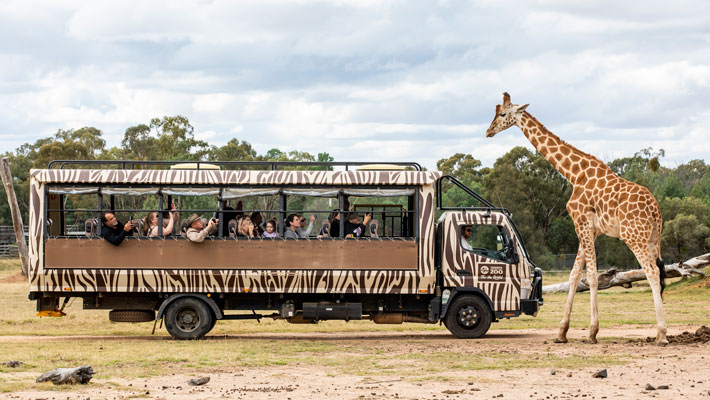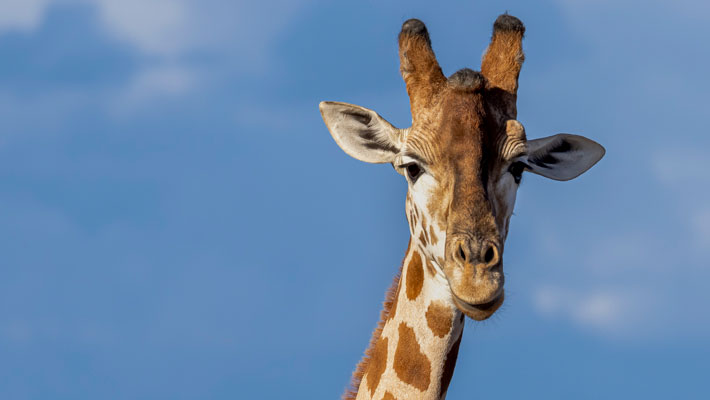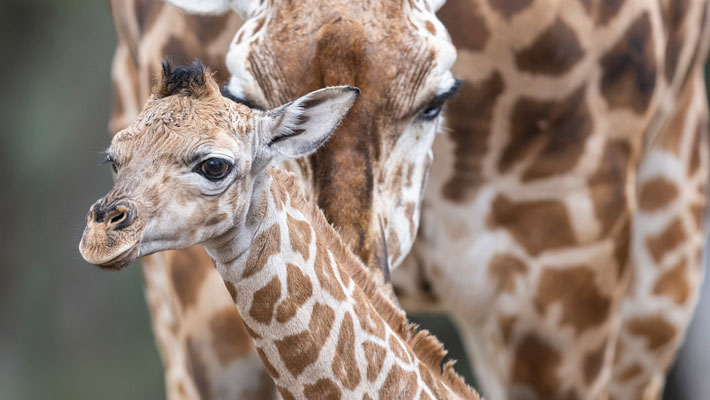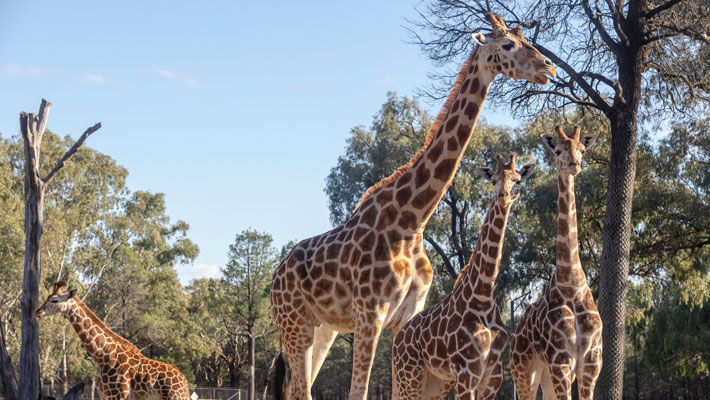Posted on 21st June 2023 by Media Relations
Our programme and wild Giraffe numbers
Here at Taronga Western Plains Zoo we have a total of 21 giraffes spread between two herds, or towers as they’re collectively known as. On our mixed-species savannah exhibit, our bachelor herd of 7 male giraffes live alongside zebra, antelope, ostrich and rhino, just like they would in the wild. This creates a unique showcase for Zoofari Lodge guests as well as visitors who can see all of these animals on one of our Savannah Safari truck tours.
On the Zoo’s main circuit you can find our 14-strong breeding herd, which has grown recently with the birth of five calves! The last calf, Shomari, was born in January of this year, and represents the 60th giraffe calf born since the breeding program began back in 1990. Taronga Western Plains Zoo is part of a well-coordinated regional breeding programme which aims to build up an insurance population of this species in human care. Across Australia and New Zealand, there are over 20 zoos working cooperatively to breed and manage giraffes, and giraffes with a Dubbo link can be found from Perth to Auckland!

Good planning ensures that the genetic health of the population is preserved through the regular exchange of animals, and with giraffes being 2 metres high at birth and capable of growing more than another metre in their first year, the logistics behind these moves have to be carefully calculated, especially when animals are being moved interstate or overseas. Prior to a move, weaned giraffe are patiently trained to enter their travel crates, so that they feel safe and comfortable during the move to their new home.
Sadly, in the three decades that we have been breeding giraffes here at Dubbo, their population in Africa has declined by more than 40% and there are now only approximately 115,000 giraffes left in the wild. Giraffes are now extinct in 7 African countries where they once roamed, and this has left them vulnerable to extinction. All of this underscores the importance of zoo-based breeding programs.

Faces in the herd
Many guests have the chance to meet our giraffes during the daily Giraffe Encounter. One of the things our guests are amazed by is the ability of the keepers to tell all the giraffes apart. Whilst at first glance they may look similar, all of the giraffes have a very individual coat pattern (and personality), which helps to identify them. The breeding herd here at the Zoo consists of 14 animals, ranging in age from 6 months to 26 years old. We are lucky enough to have 3 generations on display, with two ‘family lines’ represented.
Our oldest giraffe is Tuli, born way back in 1997 and the daughter of the first giraffe ever born here at Dubbo. Tuli is related to 8 other giraffes on the exhibit, including several of her ‘grandchildren’. She keeps a close eye on everything that is happening, and as the tallest giraffe on display certainly uses her great height to her advantage.
Born in New Zealand and arriving in Australia back in 2008 is Ntombi. Ntombi has a distinctive pinched face and darker coat colouration. In June of last year, Ntombi welcomed a female calf, and became a grandmother for the first time in October when her other daughter Nyah calved. Giraffe mothers will creche their calves and leave an adult to ‘babysit’. With five calves on exhibit, keepers are lucky enough to witness this behaviour, just like in the wild.
A key part of the breeding program is bull, Mtoto. He arrived from Mogo Zoo on the south coast several years ago and is the sire of the 5 youngest calves. He can be identified by his very dark coat pattern and solid stature. After a little time living adjacent to the herd, Mtoto has returned, generating a lot of excitement within the herd. In another 15 months or so, we may be welcoming some more calves!

Caring for our tower
Looking after 14 giraffes keeps our keepers very busy! Our giraffe team also look after the Zebra, Eland, Bongo, White Rhinoceros and Takhi (or Przewalski’s Horse).
Giraffes are browsers, with a four-chambered stomach just like a cow. In the wild, they consume between 50-65 kilograms of vegetation every day, ranging from leaves to seedpods. Here at the zoo, they don’t eat quite that much, but the herd can easily chomp through 5-6 bales of lucerne hay daily. The giraffes also eat a specially formulated pellet which supplements their diet, and some carrots as part of their daily encounter. Their favourite food is leaves, so much so that keen-eyed zoo guests will notice that the large trees in our exhibit are protected by wiring to stop the giraffes eating their home. Instead, every day the keeping team sustainably harvest a large quantity of vegetation, or ‘browse’, which is suspended in huge bunches for the giraffes to feed on. Depending on what is available, the giraffes may even eat the twigs and bark too. Eucalypt and wattle are amongst their favourites. Male and female giraffes do like to feed at different heights, which is an important consideration when presenting food to them.
Cleaning is an important component of the daily husbandry for giraffes. As you can imagine, all of that food generates a lot of faecal matter. Unlike some species like rhinos which poo in a pile, giraffes poo wherever they want. Whilst this makes a lot of work for their keepers here at the zoo, in the wild this is critical for dispersing seeds. Giraffes are the gardeners of the Serengeti. We shift our giraffes between their paddock and behind-the-scenes house and yards at different times of the day so keepers can clean these spaces safely. The giraffes are quite used to this routine and are generally very cooperative. The Zoo’s giraffe house was built back in 1976, before the zoo even opened, and provides our animals with a warm place to shelter during the winter. Fascinatingly, it isn’t just a home for giraffes, with possums, barn owls, native antechinus and even micro-bats living inside it too!
Another important aspect of caring for our giraffes is enrichment. In the wild, giraffes forage for food constantly. Whilst our giraffes always have access to their lucerne hay, keepers do like to challenge them from time to time. We can utilise tubs with tongue-sized holes in them to hide food in and create a puzzle, as well as gigantic stick piles for them to play with and scratch against, and even items like herbs. Variety really is the spice of life.

Finally, another vital component of caring for giraffes is training. Giraffes are highly intelligent and very aware of even minor changes to their environment, so depending on the individual’s personality and what behaviour needs to be trained it can take some time. Here at Dubbo, giraffes are frequently trained for travel to new homes at other zoos. In fact, Taronga Western Plains Zoo was the first zoo in the world to transport a mother and her calf in the same crate to another zoo! A recent example of successful training was with one of our young males, Losiligi, who was trained to voluntarily separate himself and enter a stall within the giraffe house, so he could undergo a medical procedure.
Guests have the chance to meet our Giraffes during the daily Giraffe Encounter. More information: taronga.org.au/dubbo-zoo/animal-encounters/giraffe